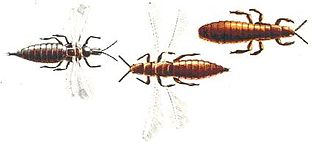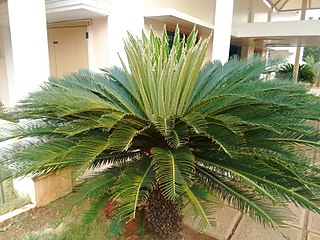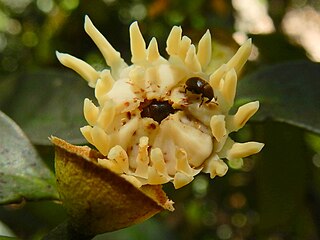
Cycads are seed plants that typically have a stout and woody (ligneous) trunk with a crown of large, hard, stiff, evergreen and (usually) pinnate leaves. The species are dioecious, that is, individual plants of a species are either male or female. Cycads vary in size from having trunks only a few centimeters to several meters tall. They typically grow very slowly and live very long. Because of their superficial resemblance to palms or ferns, they are sometimes mistaken for them, but they are not closely related to either group. Cycads are gymnosperms (naked-seeded), meaning their unfertilized seeds are open to the air to be directly fertilized by pollination, as contrasted with angiosperms, which have enclosed seeds with more complex fertilization arrangements. Cycads have very specialized pollinators, usually a specific species of beetle. Both male and female cycads bear cones (strobili), somewhat similar to conifer cones.

Thrips are minute, slender insects with fringed wings and unique asymmetrical mouthparts. Entomologists have described approximately 7,700 species. They fly only weakly and their feathery wings are unsuitable for conventional flight; instead, thrips exploit an unusual mechanism, clap and fling, to create lift using an unsteady circulation pattern with transient vortices near the wings.

Cycas is a genus of cycad, and the only genus in the family Cycadaceae with all other genera of cycad being divided between the Stangeriaceae and Zamiaceae families. Cycas circinalis, a species endemic to India, was the first cycad species to be described in western literature, and is the type species of the genus.

Bennettitales is an extinct order of seed plants that first appeared in the Permian period and became extinct in most areas toward the end of the Cretaceous. Bennettitales were amongst the most common seed plants of the Mesozoic, and had morphologies including shrub and cycad-like forms. The foliage of bennettitaleans is superficially nearly indistinguishable from that of cycads, but they are distinguished from cycads by their more complex flower-like reproductive organs, at least some of which were likely pollinated by insects.

Macrozamia is a genus of around forty species of cycads, family Zamiaceae, all of which are endemic to Australia. Many parts of the plant have been utilised for food and material, most of which is toxic if not processed correctly.

Macrozamia communis is an Australian cycad found on the east coast of New South Wales. The common name for the species is burrawang, a word derived from the Daruk Australian Aboriginal language; this name is also often applied to other species of Macrozamia.

Williamsonia is a genus of plant belonging to Bennettitales, an extinct order of seed plants. Within the form classification system used in paleobotany, Williamsonia is used to refer to female seed cones, which are associated with plants that also bore the male flower-like reproductive structure Weltrichia.

Macrozamia concinna is a part of the plant family, Zamiaceae. It originates from a division of Cycadophyta which encompasses the complete species of cycads. M. concinna is primarily habituated in New South Wales, Australia and maintains a distinct appearance allowing it to be easily identifiable from other cycads. M. concinna also implements a unique method of reproduction to fertilise its offsprings, as opposed to the common method of wind pollination. This difference in reproduction mechanisms has survived throughout the ages of prehistoric cycad species and M. concinna continues to procreate with it.

Macrozamia glaucophylla is a species of cycad from the genus Macrozamia and the family Zamiaceae. Endemic to New South Wales, Australia, this species has features that resembles palms, although both species are taxonomically quite different. The current population trend of Macrozamia glaucophylla is stable with 2,500 to 10,000 mature individuals. The species are found in several habitats including forest and savanna. Ecologically, Macrozamia glaucophylla lives in terrestrial system, a land-based community of organisms where the biotic and abiotic components interact in the given area.

Macrozamia heteromera is a species of cycad in the family Zamiaceae initially discovered by Charles Moore in 1858 and is endemic to New South Wales, Australia. It can be found in the north-western region of New South Wales within the Warrumbungle mountains and further south west towards the Coonabarabran district. It is a low trunked cycad usually at a height below 1 metre and can be found in dry sclerophyll woodlands. M. heteromera can be distinguished from the rest of the Macrozamia genus by its mid-green, narrow, usually divided pinnae and divided seedling pinnae. It is a plant that has toxic seeds and leaves, a characteristic common to cycads. However, after proper preparation and procedure, the seeds are fine for consumption.

Macrozamia macdonnellii, common name MacDonnell Ranges Cycad, is a species of plant in the family Zamiaceae. It is endemic to the Northern Territory, Australia.

Macrozamia miquelii, is a species of cycad in the plant family Zamiaceae. It is endemic to Queensland and New South Wales in Eastern Australia. Located within sclerophyll forests dominated by eucalyptus trees, the cycad grows on nutrient-poor soils. It is recognised within the Zamiaceae family for its, medium height at 1 m, intermediate size of male and female cones and lighter green leaves compared to other cycads within the plant family of Zamiaceae. The seeds have an orange red sarcotesta which attracts fauna consumption, allowing a mutualistic seed dispersal for the cycad. These seeds are also edible for human consumption if prepared correctly to remove the toxins.

Macrozamia mountperriensis is a species of plant in the family Zamiaceae endemic to the area around Mount Perry in Queensland; however, it is not considered threatened due to its large population in the area. The species was discovered by colonial botanists including Frederick Manson Bailey and James Keys in the late 1800s. All members of the Zamiaceae family are considered to be poisonous.

Macrozamia riedlei, commonly known as a zamia or zamia palm, is a species of cycad in the plant family Zamiaceae. It is endemic to southwest Australia and often occurs in jarrah forests. It may only attain a height of half a metre or form an above trunk up to two metres with long arching fronds of a similar length. The giant cones amidst the crown of palm-like fronds contain edible seeds surrounded by red sarcotesta. The seeds are consumed by birds and animals, and can be a favoured part of the human diet when prepared correctly. M. riedlei benefits from a close association with bacteria that fix nitrogen, which also produce substances found throughout the plant that are toxic to some animals when consumed. The species is cultivated for ornamental use in urban and domestic environments.

Macrozamia spiralis is a species of cycad in the family Zamiaceae. It is endemic to New South Wales in eastern Australia, where it is found in sclerophyll forest on low-nutrient soils. Plants generally lack a trunk and have 2–12 leaves that range up to 100 cm (40 in) in length.

Elleschodes is a genus of true weevils occurring in Australia, particularly Queensland. Some species are pollinators of trees in the genus Eupomatia.

The Peltaspermales are an extinct order of seed plants, often considered "seed ferns". They span from the Late Carboniferous to the Early Jurassic or the Jurassic-Cretaceous Boundary. It includes at least one valid family, Peltaspermaceae, which spans from the Permian to Early Jurassic, which is typified by a group of plants with Lepidopteris leaves, Antevsia pollen-organs, and Peltaspermum ovulate organs, though the family now also includes other genera like Peltaspermopsis, Meyenopteris and Scytophyllum. Along with these, two informal groups of uncertain taxonomic affinities exist, each centered around a specific genus ; Supaia and Comia, known from the Early Permian of the Northern Hemisphere, especially of North America. Both the "Comioids" and the "Supaioids" are associated with the peltaspermacean ovulate organ Autunia. The Late Triassic-Middle Jurassic genus Pachydermophyllum may also have affinities to the peltasperms.

Zamia integrifolia, also known as coontie palm, is a small, tough, woody cycad native to the southeastern United States, and the Bahamas.
Paul Irwin Forster is an Australian botanist. He obtained his doctorate from the University of Queensland in 2004 with his thesis The pursuit of plants : studies on the systematics, ecology and chemistry of the vascular flora of Australia and related regions.

Ctenis is a genus of fossil foliage attributable to the Cycadales, being one of the most common genera of cycad fossil leaves in the Mesozoic.

















